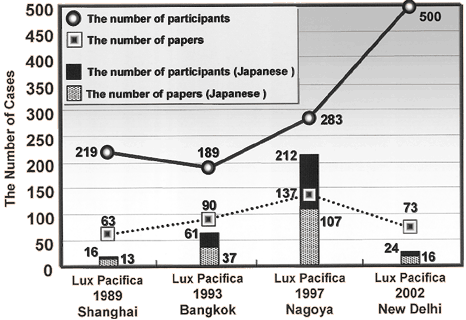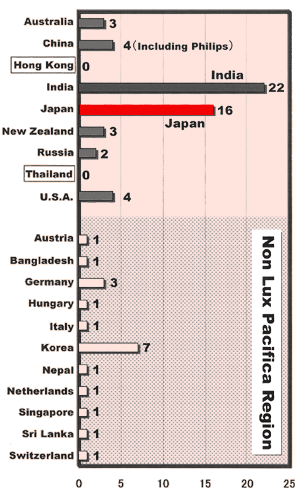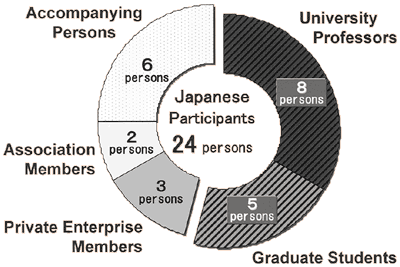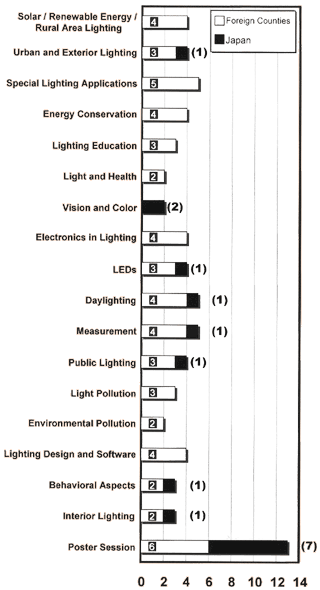The Lux Pacifica Lighting Conference Report
3. Report on Lux Pacifica 2002 – New Delhi Conference
Following is a brief report on the 4th Lux Pacifica Lighting Conference (Lux Pacifica 2002 – New Delhi).
The venue for this Conference, the Vigyan Bhavan Convention Center in New Delhi, was also used as the venue for the CIE India Conference held in 1995. Since that time, this International Conference Hall has been equipped with the latest in equipment and facilities.
We couldn’t help but be overwhelmed, however, by the overly strict security at the entrance to the Convention Center. After passing through a metal detector and a body check, all bags and briefcases containing materials for the Conference were carefully inspected. All video equipment and cameras were strictly prohibited, and even bags could not be brought inside, as we were asked to leave these at the luggage counter. The only types of bag allowed were the small handbags carried by the ladies. Lecturers who had brought laptop computers for their presentations had to go in through a special entrance to the side of the main entrance, where they underwent questioning regarding the reason for carrying the computer; the computer’s operation was checked, and the lecturers were required to sign a log book on entering and leaving the building. We wrote this all off to prevention of international terror and the effects of tension between India and Pakistan.
Once this strict security check was over, however, I found myself back inside the Vigyan Bhavan Convention Center for the first time in seven years, and every area of the Center that I visited brought back many fond memories (ref. Fig. 1).
There were a total of 24 participants from Japan, 16 of whom had submitted papers. Figure 2 shows the movement in the number of participants from the first Conference to the fourth. Figure 2 shows that the total number of participants exceeded 500 (source: Report from the Lux Pacifica Meetings held on September 9 and 11). The main reasons for the excellent turnout were participation in the exhibition by 81 companies and organizations, and the fact that the extremely popular International Lighting Exhibition, Lii 2002 at Pragati Maidan New Delhi (September 6-9) was being held in the same building. The number of papers being presented had fallen off somewhat to 73, mainly as an effect of the India/Pakistan conflict that had flared up once again earlier that summer. The Indian Society of Lighting Engineers, which was directly responsible for hosting this Conference, reported that around 50 of the original applicants had withdrawn from doing presentations.

Fig. 2: Changes in status of each Conference

Fig. 3: Number of papers presented by each participating country
Figure 3 shows the number of papers presented at this Conference by each participating country. The host country, India, had by far the largest number of presentations at 22, followed by Japan with 16, which means that Japan was the most active country aside from the host country. We believe this is an indication that Japan has already established a position as an “information provider” in the field of lighting science and technology in the Asia-Pacific Rim Region, and as such bears an important leadership role. It should be noted that before the flare-up of the India/Pakistan conflict (in April), Japan had been scheduled to present a total of 29 papers, which exceeded even the number for the host country.
As was the case at the third Conference, papers were presented by many non-member countries, indicating that Lux Pacifica is rapidly gaining recognition as an international conference. A comparatively large number of papers were submitted by applicants from Korea in particular, leading Chairman Julian to approach Korea about becoming registered as a Lux Pacifica member. A report on the results of these discussions will be presented at the International Organization Committee Meeting during the CIE San Diego Conference to be held in 2003.
On the other hand, as shown in Figure 3, there were no papers presented or participants from Thailand, which is a Lux Pacifica member country, or from Hong Kong, which is the home country of Vice-Chairman Chang. In addition, neither country has dispatched representatives to be members of the International Organization Committee. This situation is considered a problem by the Committee, and will be targeted for improvements in the future by the CIE and other related organizations.
Most of the members participating from Japan stayed at the Metropolitan Hotel Nikko New Delhi, a Japanese-owned hotel located about ten minutes walk from Connaught Place, a circular segment of the city containing many shopping malls and with Central Park at its hub. A free shuttle bus arranged by the Conference Working Committee provided transportation between the hotel and the Vigyan Bhavan Convention Center, which the participants found to be quite convenient.
The various members gathered for breakfast to exchange information on what they had learned through their walks through the city, and to deepen their mutual friendships.
Figure 4 shows the types of affiliation for the 24 participants from Japan. Specifically, 13 (54%) were affiliated with universities (8 professors and 5 graduate students); 3 (13%) were private enterprise members (2 engineers and 1 lighting designer); 2 (8%) were Association members; and 6 (25%) were persons accompanying the above 18 participants. Broken down by gender, there were 17 males (71%) and 7 females (29%). I got the impression that there was a comparatively larger number of young researchers. I was surprised to see so many graduate students traveling to an international conference overseas unaccompanied by a supervisor of studies – the times certainly are changing.

Fig. 4: Types of affiliation for participants from Japan
Table 2 gives an outline of the Conference program over three days, while Table 3 and Figure 5 show the Conference Topics and the relevant number of papers presented.
Table 2: Outline of the Conference program
| Monday,9th September | Tuesday,10th September | Wednesday,11th September | ||||||
|---|---|---|---|---|---|---|---|---|
| Ibaugral Session | Keynote Paper | Special Invited Lecture | ||||||
| Poster Session | ||||||||
| Tea break | Tea break | Tea break | ||||||
| Urban and Exterior Lighting | Solar / Renewable Energy / Rural Area Lighting | Special Lighting Applications | Special Session on LEDs | Light Pollution | Public Lighting | Application Workshop 3 retail & Exhibition Lighting |
||
| Lunch | Lunch | Lunch | ||||||
| Energy Conservation | Lighting Education | Light and Health | Special Invited Lecture | Behavioral Aspects | Lighting Design and Software | Appliccation Workshop 4 |
||
| Tea break | Tea break | Tea break | ||||||
| Vision and Color | Electronics in Lighting | Appliccation Workshop1 Office Lighting |
Measurement | Daylighting | Appliccation Workshop 2 Hospitality Lighting |
Closing Plenary | ||
| The Past meetings | Lux Pacifica 2002 |
|---|---|
|
|

Fig. 5 Number of papers presented for each Conference Topics (categorized by field)
The Opening Ceremony was held in the Plenary Hall of the Vigyan Bhavan Convention Center on the first day of the Conference (Sept. 9) from 9:00 a.m. to 2:00 p.m. Seated on the stage with Chairman Julian and Conference Working Committee Chairman Hari S. Mamak were Pranab K. Bandyopadyay, Chairman of the Indian Society of Lighting Engineers (India), CIE Chairman Hans A. Löfberg (Sweden), and Mr. J. E. Jewell (first Chairman of the Committee), along with numerous honored guests and International Committee members from various countries. After a declaration announcing the opening of the Conference, participants heard comments and greetings from each of the honored guests. The capacity of the Plenary Hall seemed incredibly huge given the number of participants, and with all of the empty seats, I couldn’t help but feel a little overwhelmed (ref. Fig. 1).
As shown in Table 2, the main features of the Conference Program following the Opening Ceremony were that the keynote paper (LED lighting), the special sessions related to the keynote paper, and the invited papers were all conducted separately, and that there were workshops on four themes related to lighting applications (Workshop 1: Office Lighting; Workshop 2: Hospitality Lighting; Workshop 3: Retail & Exhibition Lighting; Workshop 4: Theme Environments and Public Spaces).
Furthermore, as shown in Table 3, the general papers covered a much wider range of topics than at past conferences: (1) Use of Solar Lighting; (2) Use of Natural Energy, (3) Rural Lighting; (4) Urban & Exterior Lighting; (5) Lighting in Special Environments; (6) Energy Conservation; (7) Lighting Education; (8) Lighting and Health; (9) Vision and Color; (10) Electronics in Lighting; (11) LED Lighting; (12) Daylighting Design; (13) Light Measurement; (14) Public Lighting; (15) Lighting Pollution; (16) Environmental Pollution; (17) Lighting Design and Software; (18) Psychology of Lighting; and (19) Interior Lighting.
As shown in Figure 5, the papers presented were spread out fairly evenly over each of these very diverse topics. Participants from Japan were also evenly dispersed over a wide range of topics, enabling a very thorough exchange of information regarding the various achievements, studies, and technologies with specialists in each of these fields. Overall, we feel that Japanese participants made a major contribution to the Conference in this regard. Over half of the presentations in the poster session were given by Japanese participants, so that at first glance this segment appeared somewhat lacking in international flavor, but many visitors took the time to come to the Exhibition Hall for this event, setting the stage for very lively and heated Q&A sessions (ref. Fig. 1).
Abridged translations of the papers presented by Japanese participants (16 papers) will be published on the “Document Introduction” page of the IEIJ Journal over several issues (starting from the April 2003 issues). We hope you will take a moment to look them over.
The Closing Ceremony was held on the last day of the Conference (Sept. 11). Perhaps it was because the Farewell Theme Dinner had been scheduled for that evening, but most of the accompanying persons (the ladies) had excused themselves from the Ceremony to get dressed. As a result, it seemed that the number of participants was comparatively small, and the Japanese participants who had all gathered for The Closing Ceremony seemed to stand out all the more.
At The Closing Ceremony, there was a series of reports on the Conference proceedings and several closing speeches, as well as a commemorative signing of an exchange agreement between the Indian Society of Lighting Engineers and the Illuminating Engineering Society of Australia and New Zealand. After all this was done, I felt a huge sense of relief that seemed to permeate my entire being.
Through the entire closing ceremony, Mr. Mamak, the Chairman of the Conference Working Committee, refused to give out any details on the theme of the official dinner to be held that evening.
The official dinner began at 8:00 p.m. at the banquet hall of the Ashok Hotel. This is the hotel where I stayed during the CIE India Conference in 1995, so I was treated to yet another nostalgic experience.
For some reason, the free shuttle bus did not drive into the grounds of the Ashok Hotel, but simply stopped at the roadside near the hotel, where we all got off. Members from other countries who had already arrived were gathered along the darkening walkway.
As we stood waiting, talking, and not knowing exactly what to do, we were suddenly greeted by crashing percussion instruments at the head of the line, accompanied by a large group of men and women in traditional costume dancing what appeared to be a Samba. Then, two beautifully painted elephants were led by elephant trainers onto the grounds near where we stood.
Mr. Mamak finally arrived, exclaiming in a booming voice, “A traditional Indian wedding ceremony will be held in the banquet hall, and I would like all of you to attend. Please fall in line with these dancers – you can all dance together.” The elephant trainers said there was no need to be afraid, and that we were free to take pictures, so we all took photos, although rather cautiously. I remember thinking how warm the elephants’ ears were.
After 20 or 30 minutes of thunderous percussion music and dancing in a circle, we arrived at the entrance hall of the Ashok Hotel. The dance approached its climax, and I was surprised to see the Japanese ladies dancing right along with these very uninhibited dancers.
On entering the banquet hall, we were offered welcome drinks; after a short wait, the bride and groom arrived, and the wedding ceremony began. Chairman Julian and his wife went to the stage to act as the formal go-between so often seen in Asian wedding ceremonies. When the ceremony was done, we were treated to a dance by several lovely young Indian ladies, and the banquet began, overflowing with music. The festive atmosphere of all those who had participated in the wedding carried over into our own dinner, and I must admit that I was most impressed with the whole gala affair. The gathering gradually began to break up after around 10:00 p.m., and we returned to our hotels bringing with us a well-earned weariness as our souvenir (ref. Fig. 1).
| forward | 1 | 2 | 3 | next |